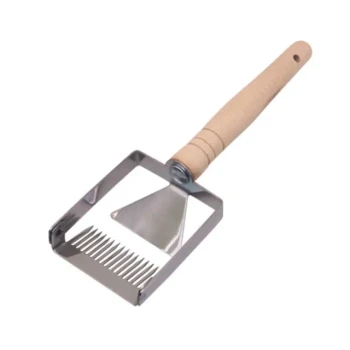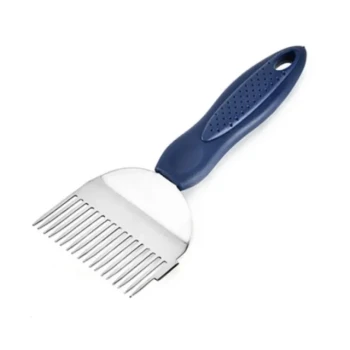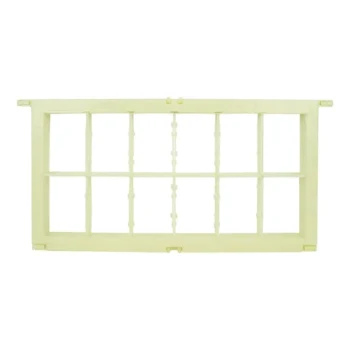At its core, the "universal hive" is not a unique type of hive but a management system. It is constructed by placing a simple division board within a standard 8-frame hive body, typically between the fourth and fifth frames, effectively creating two 4-frame compartments within a single box.
The central purpose of the universal hive system is to provide beekeepers with maximum flexibility. By using a single piece of equipment—the division board—a standard hive can be instantly converted into a tool for making splits, managing brood, or intensifying honey production.
The Core Concept: A Hive Within a Hive
The universal hive's design hinges on a simple principle: dividing a larger space into smaller, more manageable units. This allows a beekeeper to manipulate colony dynamics without needing a large inventory of specialized equipment.
Simple and Standard Construction
The setup requires no special boxes. It uses a standard 8-frame hive body and a division board.
The board is inserted snugly between the 4th and 5th frames. This action transforms the 8-frame box into two separate 4-frame nucleus hive ("nuc") compartments.
The Principle of Division
With the division board engaged, you can manage two small, independent colonies within one hive body. Each side can function as its own unit.
Alternatively, you can manage a single colony on one side of the board, restricting its space to just four frames for specific management purposes.
Practical Applications and Use Cases
The true value of this system lies in its versatility. Depending on the season and your goals, the same hive can be used in several distinct ways.
Creating a Split or "Increase"
This is one of the most powerful uses of the universal hive. You can place a queen on one side of the division board and allow the other, now queenless, side to raise a new queen or accept a queen cell.
This effectively turns your hive into a mating nuc or a resource for creating new colonies with minimal equipment.
Maximizing Honey Production
To focus a colony on honey storage, the division board is used to restrict the queen's laying area to just four frames.
A queen excluder is placed on top of this single hive body, and honey supers are added above. This compact brood nest encourages the foragers to store incoming nectar in the supers rather than the brood box, potentially leading to a larger honey harvest.
Brood Nest Management and Assessment
Using the division board creates a hard boundary for the colony. This makes it exceptionally easy to assess the brood nest.
You can quickly see if the queen has filled the four available frames with eggs, larvae, and pupae, giving you a clear and standardized indicator of her performance and the colony's overall health.
Understanding the Trade-offs
While flexible, this system requires careful management and an understanding of its potential downsides. It is not a "set and forget" solution.
Increased Swarm Risk
Restricting a productive queen to only four frames can rapidly lead to overcrowding in the brood nest.
If you don't provide ample space in the honey supers at the right time, this intense congestion will quickly trigger the colony's swarm impulse.
Requires Precise Timing
The honey production strategy relies on restricting the queen just before the main nectar flow.
If you restrict her too early, you may limit the colony's population growth, resulting in a smaller foraging workforce when the flow begins. If you do it too late, you miss the opportunity.
Colony Size Limitations
While excellent for splits and targeted goals, a 4-frame brood nest cannot sustain a massive colony long-term. The system is designed for temporary configurations to achieve a specific outcome, after which the division board is often removed to allow for expansion.
Making the Right Choice for Your Goal
The universal hive is a technique, not a prescription. How you use it should be dictated entirely by what you want to achieve with your bees.
- If your primary focus is making colony increases: Use the hive as a "two-in-one" nuc box to raise new queens or grow out splits with minimal equipment.
- If your primary focus is maximizing honey production: Use the division board to restrict the queen's laying space just before the main nectar flow, forcing bees to store honey in the supers.
- If your primary focus is efficient colony assessment: Use the 4-frame compartment as a standardized unit to quickly gauge queen performance and brood health.
Ultimately, mastering the universal hive system empowers you to manage your colonies more dynamically with the equipment you already own.
Summary Table:
| Use Case | Primary Goal | Key Action |
|---|---|---|
| Creating Splits | Colony Increase | Divide hive into two 4-frame nucs for queen rearing. |
| Maximizing Honey | Boost Harvest | Restrict queen to 4 frames to focus bees on supers. |
| Brood Assessment | Monitor Health | Use 4-frame compartment for quick queen/health checks. |
Ready to implement the universal hive system in your operation?
HONESTBEE supplies the durable, standard 8-frame hive bodies and precision division boards that make this flexible management technique possible. Our wholesale-focused operations provide commercial apiaries and beekeeping equipment distributors with the reliable supplies needed to master dynamic beekeeping.
Contact HONESTBEE today to discuss your equipment needs and boost your apiary's efficiency.
Related Products
- Automatic Honey Flow Beehive 4 Frame Mini Hive for Beekeeping
- Honey Flow Garden Bee Hive Flow Hive Best Beehive for Beginners
- Professional Stainless Steel Uncapping Fork with Wooden Handle
- Professional Insulated Plastic Bee Hives
- Wholesales Dadant Size Wooden Bee Hives for Beekeeping
People Also Ask
- What are the efficiency benefits of using a Flow Hive for honey harvesting? Unlock a Gentle, On-Demand System
- Can you harvest wax or honeycomb from a Flow Hive? Unlocking the True Design Purpose
- Why do new beekeepers often adopt the Flow Hive? Simplify Honey Harvesting for Beginners
- How does the Flow Hive address the issue of honey crystallization? Prevent and Manage Crystallization
- Why is the Auto Flow Hive better for the bees? Minimizing Stress with Non-Intrusive Harvesting



















